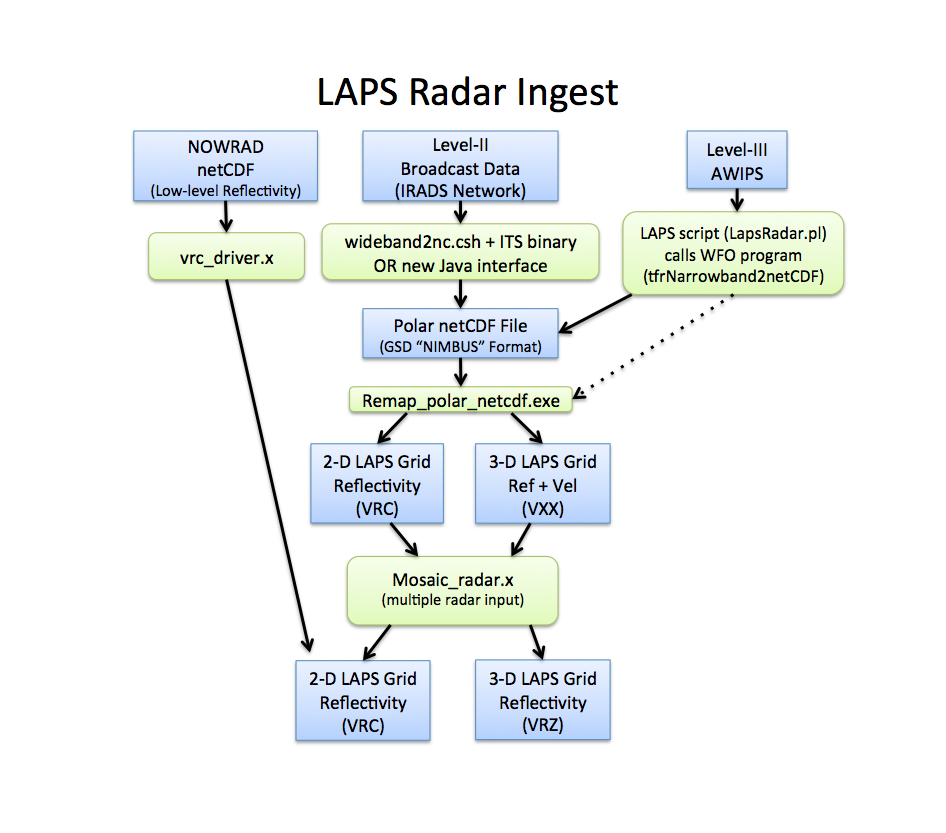
The wideband (gate by radial) radar data are processed by a combination of programs running within the ESRL/GSD Information and Technology Services (ITS) and as part of the LAPS ingest.
Below is a typical chain of events for wideband radar ingest pre-processing and processing.
PROCESS INPUT OUTPUT WHERE
------- ----- ------ -----
1. Archive-II files IRaDS RT data stream Archive-II ITS
2. Polar NetCDF Writer Archive-II Polar NetCDF tilt/vol ITS or LAPS
3. Remap_polar_netcdf.exe Polar NetCDF tilt/vol 'v01' LAPS file LAPS
4. 2D/3D Mosaic 'vrc'/'v01' files 'vrc'/'vrz' files LAPS
As a preface, please note that all the standard LAPS ingest needs is
a Polar NetCDF file, obtainable by any means possible. You are thus at
liberty to substitute your own individual processing and software for
some or even all of the steps (1-4). As an example, in our
LAPS Radar Ingest Flow chart (click image to enlarge),
note that there is more than one method for
generating the Polar NetCDF file.
Files such as 'vrc', 'v01', 'vrz' are described in the main LAPS README, and are
available as NetCDF files, for which examples can be seen under 'lapsprd'. These
are on the LAPS Cartesian grid using the LAPS map projection for the particular domain.
'v01'
is generated as NetCDF or run-length encoded compressed format, depending on LAPS namelist
settings.

At present, we frequently obtain WSR-88D output (from RIDDS/RUDDS) for a number of radars around the U.S. available via a remote data access project called IRaDS (formerly CRAFT). We have a way to interface LAPS with retrospective Level II radar data that can be requested at this link from NCDC that is similar to the IRaDS format. Note that once you obtain Level II radar data from these sources it will still have to be converted into the Polar NetCDF files for LAPS.
ITS processes the realtime IRaDS data stream and stores the most recent several hours of this on disk in Archive-II format. The Archive-II data for real-time data exist as one tarred and gzipped file for each volume scan as in this example. As mentioned, retrospective Archive-II datasets can be obtained at this request link from NCDC . On the request page you can select "NEXRAD Level II", and then the "Submit Selections" button. This clickable map can help in selecting the radars.
After making the submission you will receive an email from NCDC with a "HAS" number. This number can be used as an argument to the '$LAPSINSTALLROOT/etc/pullncdcradars' script that downloads the radars using 'wget'.
ITS has developed a follow on software package that utilizes the Archive-II data files as input. The 'ArchiveNexrad2NetCDF' executable program within the package (2) does a reformatting and writes out the polar netCDF files (one file per tilt) as in this sample dataset that LAPS uses. 'ArchiveNexrad2NetCDF' is invoked by a script integrated within LAPS called '$LAPSINSTALLROOT/etc/wideband2nc.csh'. The software may be installed as a separate add-on to LAPS; the latest version may be obtained from ITS either as source code or as a precompiled executable.
A new Java package is being tested that also reads the Archive-II files as input, then writes out polar NetCDF radar data in one file per volume scan. The Java tar file is available here:
A related package known as the "LDM to NetCDF" conversion software is an alternative method of generating the polar NetCDF files. This represents a combination of steps 1 & 2. For further information about either of these ITS software packages please contact Bob Lipschutz of ITS.
For the most part the polar NetCDF output files are self describing. Running 'ncdump' on such a file will show the various flag value settings. The "Fill Value" can be used to denote areas of invalid data or regions not scanned by the radar. Otherwise, the count values are processed by lookup tables - these are specified within the remapper input subroutine 'get_data_field' in LAPS source file 'src/ingest/radar/remap/netcdfio.f'.
The 'remap_polar_netcdf.exe' program runs as an integral part of LAPS as an ingest process.